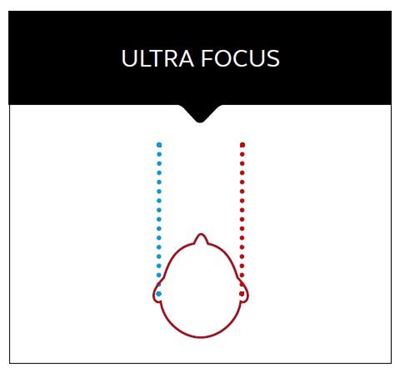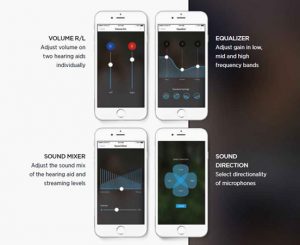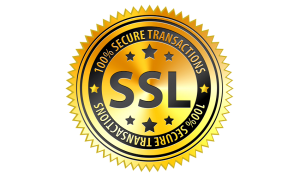ReSound's Ultra Focus
There may be some specific situations where a hearing aid wearer may need to focus only on speech in a one-to-one conversation with someone they are facing.
The Reasoning Behind ReSound Ultra Focus
Speech Intelligibility.
Some listening environments consist of busy and complex noise, where an individual speaker’s voice may blend into the mix. When in that type of environment, it is likely that a listener would employ a listening technique where they would face their conversational partner so that they could see visual cues as well as the sound of the person’s voice.
In the hearing aid world, It has also been shown that a bilateral directional response in hearing aids can improve speech recognition for speech in front relative to an asymmetric response when the noise background is diffuse (5 & 6).
To support this listening strategy as well as possible, a “Speech Intelligibility Mode” steers both hearing aids to a strong directional response using binaural beamforming technology. This technology is unique in the way it enhances Signal to Noise Ratio’s (SNR) in the speech important frequencies while preserving hearing cues in both ears.
ReSound’s Ultra Focus is a wearer selectable program offered for the first time in ReSound ONE hearing aids. Ultra Focus allows wearers to override the hearing aids automatic settings in these special circumstances. For example, airports are notoriously noisy places where it can be challenging to hear a specific ticketing agent.
With noise and speech coming from other nearby sources, ReSound’s “All Access Directionality” might steer the hearing aids sound setting’s mode to “binaural listening”. But because the wearer’s intention is to hear just one person in a challenging sound environment, the sound settings might be best if applied by manually changing to Ultra Focus.
Ultra Focus is a special listening program designed to maximize the clarity of speech in a one-to-one conversation.

The settings for Ultra Focus include the activation of the binaural beamformer at the lowest crossover frequency of 550 Hz, which can improve the Signal to Noise Ratio (SNR) by up to 2 dB, or approximately a 30% improvement in speech recognition. In addition, speech clarity is prioritized in Ultra Focus.
A slow time constant scheme is used to maintain the temporal envelope of speech as well as short term changes in the spectral pattern of sounds which convey information in speech (1 & 2). This also helps preserve short-term level changes, such that cues for localization based on Interaural Level Difference (ILD) are not markedly disrupted.
Acoustic environments where users might want to activate the Resound Ultra Focus feature is likely to be reverberant as well as noisy. NoiseTracker II noise reduction is therefore set to a moderate level for minimum signal distortion (3) and based on recent findings indicating that use of strong noise reduction in reverberation adversely affects SNR, speech recognition, and listening effort without significantly adding to listening comfort (4).
REFERENCES
- Drullman R, Festen JM, Plomp R. Effect of temporal envelope smearing on speech reception. The Journal of the
Acoustical Society of America. 1994 Feb;95(2):1053-64. - Kluender KR, Coady JA, Kiefte M. Sensitivity to change in perception of speech. Speech Communication. 2003 Aug 1;41(1):59-69.
- Rallapalli V, Anderson M, Kates J, Balmert L, Sirow L, Arehart K, Souza P. Quantifying the Range of Signal Modification in Clinically Fit Hearing Aids. Ear and Hearing. 2020 Mar 1;41(2):433-41.
- Reinhart P, Zahorik P, Souza P. The interaction between reverberation and digital noise reduction in hearing aids: Acoustic and behavioral effects. The Journal of the Acoustical Society of America. 2017 May;141(5):3971.
- Hornsby B. Effects of noise configuration and noise type on binaural benefit with asymmetric directional fittings.
Seminar presented at: 155th Meeting of the Acoustical Society of America; June 30-July 4, 2008; Paris, France. - Kirkwood B, Jespersen CT. How asymmetric directional hearing aid fittings affect speech recognition. Canadian Audiologist;4(1). Available from: https://www.canadianaudiologist.ca/issue/volume-4-issue-1-2017/asymmetric-speech-recognition-feature/.
For more information on ReSound’s Ultra Focus technology, chat or call HearSource at 1-800-416-2434, 9:00 a.m. to 9:00 p.m. Eastern Time (6:00 a.m. to 6:00 p.m. Pacific Time) USA.




